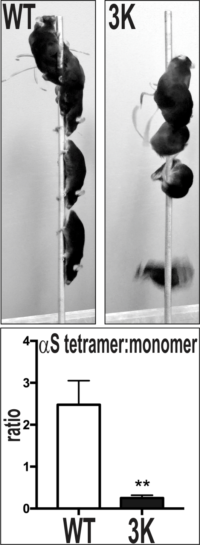The Nuber lab is dedicated to study the one of the top-most genetic risk factors for Parkinson’s disease — α-synuclein — in (postmortem human) brains of Parkinson’s disease and Dementia with Lewy bodies and in close rodent models thereof.
Our research was and is currently funded by the NIH-NINDS, the Michael J Fox Foundation, and generous gifts of the Orchard Foundation and of the Women’s Brain Initiative.

We are using transgenic mice modeling PD-relevant α-synuclein tetramer-abrogation by expressing the human mutant or wild-type α-synuclein and its amplifications (i.e. triplication) under the control of neuronal promoters. The mice recapitulate human α-synucleinophaties down to the ultrastructural level. The motor behavior of the human (E35K, E46K, E61K) 3K α-synuclein mice is impaired in an age-dependent manner, starting at 3 months (3K) and fully developed by age of 6 months. The striking PD-like phenotypes are based on the upstream loss of physiological tetramers toward excess of monomers that cluster at vesicle membranes (see our Figure and Nuber et al., Neuron, 2018), and these develop more mildly in our lower expressing ‘3KL’ and familial PD (E46K) 1K α-synuclein mutant mouse lines. Our interest is to understand the mechanisms and earliest changes that occur in vivo by promoting tetramer-abrogation (i.e. by 3K mutant α-synuclein) when compared to bone fide familial (e.g. E46K or G51D) PD mutations.
One of our major research endeavors in our lab is to investigate endocrine neuroprotection in models of PD since we found female sex to restore the physiological tetramer:monomer level, contributing to neuroprotection of dopaminergic function, similar to human PD (Rajsombath et al., JNeurosci, 2019). We use estrogen, and estrogen receptor modulators to study its impact on α-synuclein biology.
The lipid desaturase SCD is a key enzyme associating with α-synuclein tetramerization vs. toxicity in cell culture and in non-vertebrate models. We are investigating the impact of lipid modulators on α-synuclein pathophysiology by changing the lipid saturation state using genetic crossings and/or by pharmacological inhibition in mice.
Lysosomal vesicle accumulations were observed in Lewy body-type lesions of familial and sporadic PD, and progressively accumulate into large and round-sized deposits by tetramer-abrogation in our 3K α-synuclein mutant mice. Deficiency in GBA, a lysosomal lipid-modulator, is the major PD risk factor and impacts the α-synuclein tetramer:monomer ratio in human cell culture. We analyze mechanisms induced by GBA overexpression implicated in α-synuclein tetramerization and clearance.